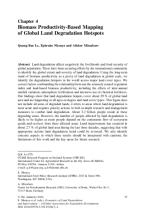Land Library
Welcome to the Land Portal Library. Explore our vast collection of open-access resources (over 74,000) including reports, journal articles, research papers, peer-reviewed publications, legal documents, videos and much more.
/ library resources
Showing items 1 through 9 of 27.Presentation on Measurement of the Costs of Land Degradation in the Mountains of the Republic of Tajikistan delivered during the CACIP Regional Consultation Meeting held in Dushanbe, Tajikistan.
This report aims to illustrate how selected companies in Malawi, Mozambique and Malaysia are implementing commitments to international best practices on land rights.
In response to the severe economic, social, and environmental costs of degradation across Tunisia’s rangelands, the International Center for Agricultural Research in the Dry Areas (ICARDA) has worked with the General Directorate of Forestry (Direction Générale des Forêts, DGF) to draw up a new pa
This document presents the Strategic Plan of the International Center for Agricultural Research in the Dry Areas for the period from 2017 to 2026.
Non-tropical dry areas cover over 40% of the world’s land surface with a growing population of more than 2.5 billion people. These people grow 44% of the world’s food and keep half of the world’s livestock, yet one in six live in chronic poverty.
Egypt, where the mean temperature is expected to increase by 1−1.5°C over the next two decades, is particularly concerned with climate change in the Medi- terranean.
Teff, Eragrostis tef /zucc./ Trotter is one of the most important cereal crops in Ethiopia that occupies (32%), the largest cultivated area under cereals and 26% of the whole area cultivated to annual field crops by covering about two million hectares of land annually.
Land degradation affects negatively the livelihoods and food security of
global population. There have been recurring efforts by the international community
to identify the global extent and severity of land degradation. Using the long-term







